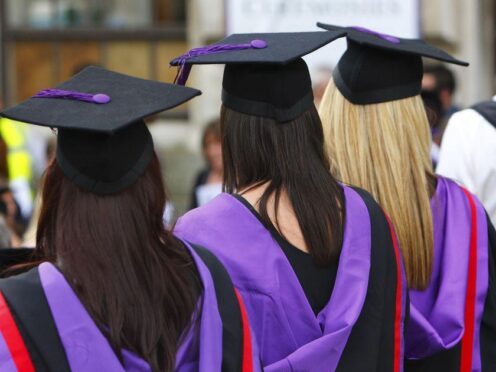Poorer students in England who are currently in their first year of university could graduate with an average debt of £60,000, a report has suggested.
Students from lower-income backgrounds have been leaving university with the “highest levels of debt” since the abolition of maintenance grants in England, the Sutton Trust charity has said.
An analysis by London Economics highlighted the “debt gap” at graduation between poorer students – from households with incomes of £25,000 or less – and wealthier students – from households with incomes above £62,000.
The research, carried out for the Sutton Trust, estimates that poorer students could graduate with £60,100 of debt – which is £16,500 more than the £43,600 for those from wealthier families.
Many students from lower-income families are also “struggling financially” with basic living costs as maintenance levels have “failed to rise with inflation”, the Sutton Trust has warned.
Full-time students from households with incomes of £25,000 or less can currently access a maintenance loan of up to £9,978 a year if they are living away from home outside London.
The charity is calling for an increase in the overall amount of maintenance available to students in England to better reflect the living costs they face, as well as the reintroduction of maintenance grants for poorer students, which were abolished in England in September 2016.
Parental income thresholds – used to determine how much support a student can receive – should be increased as these thresholds have been frozen, it said.
Ahead of the upcoming general election, the report also called for changes to repayment terms to make the system “more progressive” – with higher-income students paying back more than under current terms, and lower monthly repayments for lower income graduates.
It concluded: “The current student finance system does not work for students from the poorest families, and risks locking many out of higher education.”
Sir Peter Lampl, founder of the Sutton Trust, said: “It’s outrageous that the poorest students are racking up the highest levels of debt.
“These students are the most debt-averse, so under the current system this increasingly deters them from going to university.
“All political parties must commit to re-introducing maintenance grants, and overall levels of maintenance should be increased, so that students can meet their basic needs without graduating with excessive debt.
“There’s absolutely no excuse for failing to create a fairer system.”
Professor Dame Sally Mapstone, president of Universities UK (UUK) and vice-chancellor of the University of St Andrews, said the report highlights the “urgency of addressing the inadequate maintenance package”.
She said: “Without action, we run the risk of deterring disadvantaged students from attending university due to financial pressures.
“Responding to the rising costs of utility bills, rent and food, universities have stepped up efforts to alleviate financial pressures during the cost-of-living crisis. However, it’s imperative that the maintenance support package in England is reviewed to reflect recent rates of inflation.”
She added: “We want to prioritise reinstating maintenance grants for those who need them most and to uprate maintenance loans to reflect real rates of inflation and changes to household incomes to ensure future students have the same opportunities as those of the last decade”.
Lee Elliot Major, professor of social mobility at the University of Exeter, said: “Higher education is facing a cost-of-learning crisis that is creating a new generation of academic haves and have nots.
“While some students can rely on the bank of mum and dad to get by, others are living on the breadline which inevitably compromises their study and damages their academic prospects.
“The cherished principle at the heart of higher education – that those with the potential to benefit from academic study should not be hampered by material deprivation – has been abandoned for this generation of students.
“Any government that is serious about social mobility would reinstate maintenance grants for students from under-resourced backgrounds.”
A Department for Education Spokesperson said: “Our student finance system ensures that the highest levels of support are targeted at students from the lowest-income families. We are increasing loans and grants for living and other costs for a further year and tuition fees will also be frozen for the seventh year running to reduce the initial amount of debt students will take on.
“The Office for Students is allocating an additional £10 million to support students who are struggling financially or with their mental health. This is on top of the £276 million of government support that universities can draw on to support their students in need.”
